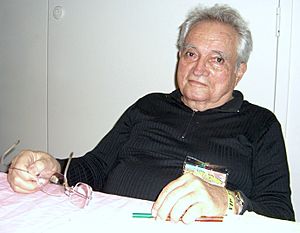Russ Heath facts for kids
Russell Heath Jr. (born September 29, 1926 – died August 23, 2018) was a famous American artist. He was best known for his amazing work in comic books. Russ Heath drew many war stories for DC Comics. He also created art for the "Little Annie Fanny" feature in ... magazine during the 1960s.
Heath also made art for advertisements. Two of his most famous pieces showed battle scenes. One was from Ancient Rome and the other from the American Revolutionary War. These pictures were used on the back covers of many comic books. They became very well-known parts of American culture from the 1960s to the 1970s.
Some of Heath's drawings of fighter jets were used by pop artist Roy Lichtenstein. Lichtenstein used them as the basis for his famous oil paintings. These paintings include Whaam!, Blam, Okay Hot-Shot, Okay!, and Brattata. Heath was never given credit or paid for his original drawings.
In 2009, Russ Heath was honored. He was added to the Will Eisner Comic Book Hall of Fame. This is a very special award for comic book artists.
Contents
Early Life and First Steps in Art
Russ Heath grew up in New Jersey. He was an only child. From a young age, he loved to draw. He was inspired by Western artists because his father used to be a cowboy. Will James and Charlie Russell were some of his favorites. He admired Charlie Russell because his art felt very real.
Heath mostly taught himself how to draw. He started working for comic companies while still in high school. During summer breaks, he drew and inked parts of "Hammerhead Hawley." This was a naval story in Captain Aero Comics.
Heath was in the Montclair High School class of 1945. He joined the United States Air Force in 1945. He served for nine months in the U.S. during World War II. While in the Air Force, he drew cartoons for his camp newspaper. After his military service, he returned home. He graduated from high school, got married, and started a family.
Starting a Career in Comics
After high school, Heath looked for work as an artist. He first got a job as an office helper at an advertising agency. He earned $35 a week. He kept looking for art jobs during his lunch breaks. In 1947, he found a staff artist job at Timely Comics. This company later became Marvel Comics. He earned $75 a week there.
At first, Heath worked in the Timely offices. But soon, he found it easier to work from home. He and his wife lived with his parents for two years. They saved money to buy their own house. Later, they had children but eventually divorced.
Heath believed his first work for Timely was a Western story. It featured the Two-Gun Kid. Historians think his first work might have been a Kid Colt story in Wild Western in 1948. His first superhero story was likely a Witness story. It appeared in Captain America Comics in 1949.
Drawing Many Types of Comics
Heath drew many Western stories for Timely comics. These included titles like Wild Western and Arizona Kid. As Timely became Atlas Comics in the 1950s, Heath drew other types of stories. He drew the first issue of the superhero series Marvel Boy. He also drew science fiction, crime stories, and horror comics. He even drew for funny magazines like Mad.
Heath also created many war stories. He drew for Timely war titles. He also contributed to Frontline Combat by EC Comics. In 1954, he started drawing war comics for DC Comics. These included Our Army at War and Star Spangled War Stories.
Later Comic Book Work
In 1961, Heath helped create "The Haunted Tank" for G.I. Combat. He worked with writer-editor Robert Kanigher. Heath also helped create and draw the first issues of DC's Sea Devils. This comic was about a team of scuba-diving adventurers. Paul Levitz, a writer and executive at DC Comics, praised Heath's art. He said Heath was a "master of texture and lighting." He could draw every tiny detail, like barnacles on a sunken ship.
Heath's drawings of fighter jets in All-American Men of War were used by pop artist Roy Lichtenstein. Lichtenstein's famous paintings Whaam! and Blam were based on Heath's art. Heath was known for making his military comics look very real.
Around the 1960s, Heath drew two advertisements. These became very famous. They showed battle scenes for toy soldier sets. One showed Roman soldiers and the other Revolutionary War soldiers. These ads appeared on the back of many comic books for years.
Later in his life, Heath lived in different cities. He worked as an animator for Saturday-morning TV cartoons. He also created art for comic fans. One rare time he worked on superhero art was when he inked Michael Golden's drawings for Mister Miracle. He also drew The Lone Ranger comic strip starting in 1981. His last comic book story was in The Immortal Iron Fist in 2009. He continued to draw cover art for other comics until 2011.
Awards and Recognition
Russ Heath received several important awards for his work.
- In 1997, he won an Inkpot Award.
- In 2009, he was inducted into the Will Eisner Comic Book Hall of Fame.
- He received the Sergio Award from the Comic Art Professional Society in 2010.
- In 2014, he won the Milton Caniff Award from the National Cartoonists Society.
- In 2018, he received the Inkwell Awards Stacy Aragon Special Recognition Award. This award honored his amazing work as a comic book inker throughout his life.



